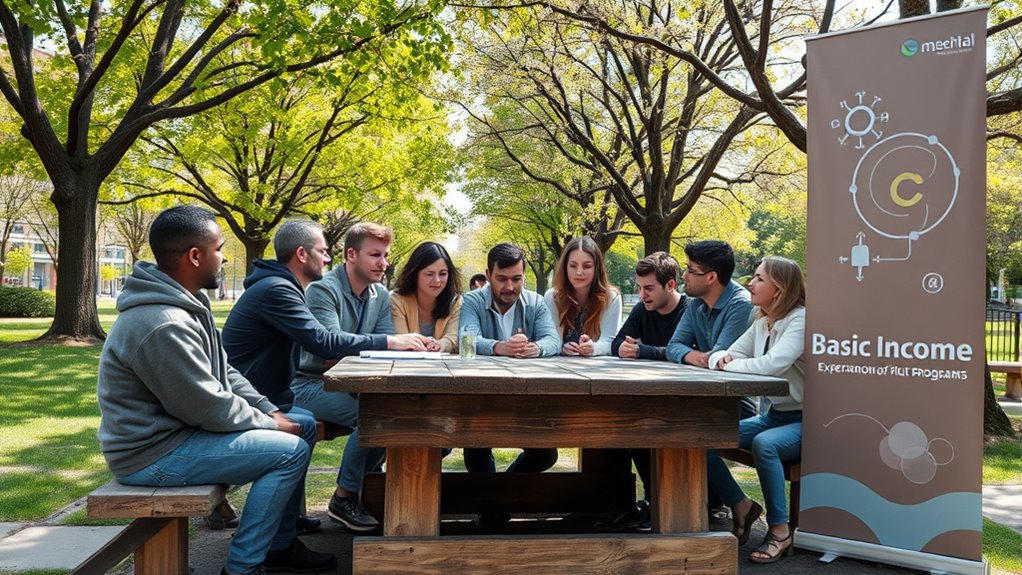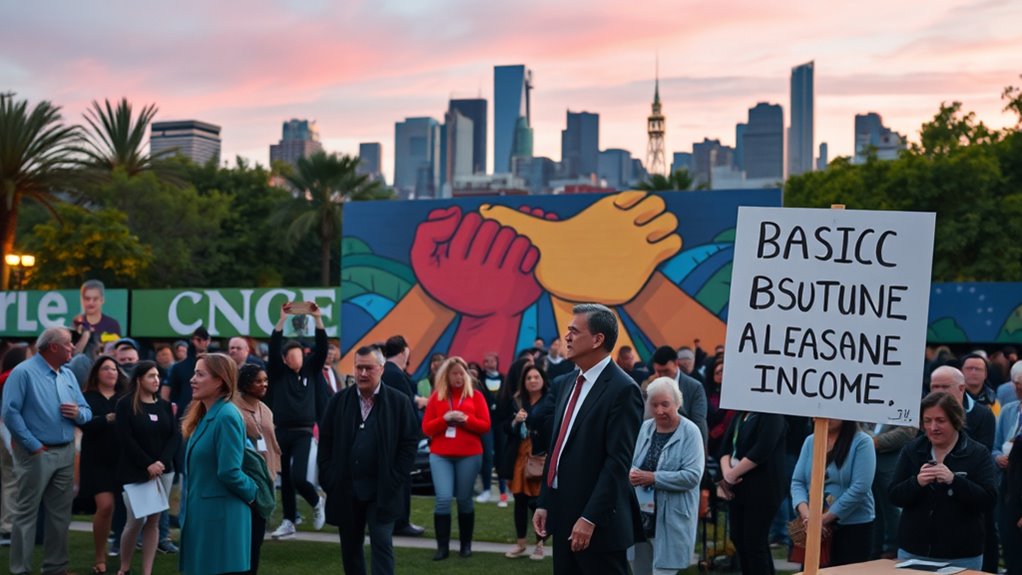Despite clear partisan divides, surprising alliances are forming around universal basic income (UBI). Support comes from younger Democrats and a significant portion of Black and Hispanic communities, while some conservatives see potential benefits too. Public opinion varies greatly across demographics, influenced by media coverage and real-world trials. The complex politics of UBI show how economic fears and social needs are crossing traditional lines—if you keep exploring, you’ll uncover how these unlikely partnerships are shaping the future of social policy.
Key Takeaways
- Support for UBI spans unlikely alliances, with some conservatives backing pilot programs to address automation’s economic impacts.
- Demographic divides reveal unexpected allies, such as Black and younger voters favoring UBI despite partisan stereotypes.
- Media framing creates unconventional coalitions, highlighting benefits for marginalized groups across ideological lines.
- Some Republican-led states have experimented with or opposed UBI, reflecting complex political motivations beyond traditional party views.
- International pilot programs and cross-party discussions showcase surprising collaborations in exploring UBI’s potential.
The Partisan Divide on Universal Basic Income

The partisan divide over universal basic income (UBI) is striking, with clear differences in support and opposition along party lines. You see, 54% of U.S. adults oppose a federal UBI of about $1,000 monthly, while 45% support it. Nearly 80% of Republicans and Republican-leaning independents oppose UBI, with 62% strongly opposed, whereas 66% of Democrats favor it, though only a third strongly support it. Independents are divided, with 56% in favor. Support varies within parties; younger Republicans and those in lower-income households show more openness, but overall, Republicans tend to oppose UBI due to skepticism about government responsibility and concerns over funding. The divide remains sharp, yet some shifts and potential coalitions hint at changing dynamics. Partisan attitudes towards UBI are influenced by broader ideological views and perceptions of social safety nets. Additionally, understanding the economic implications of implementing UBI can influence public opinion and political stances across the spectrum.
Demographic Trends and Support for UBI

Support for universal basic income (UBI) varies markedly across demographic lines, with age, race, and income shaping opinions more than party affiliation alone. You’ll find that 67% of 18–29-year-olds favor UBI, double the opposition, while only 26% of those 65 and older support it. Support declines steadily with age, dropping to 49% among 30–49-year-olds and 40% among 50–64-year-olds. Racially, Black adults lead support at 73%, followed by Hispanic adults at 63%, with only 35% of White adults in favor. Income also influences views: lower-income households strongly support UBI, whereas middle- and higher-income groups tend to oppose. Younger, lower-income, and minority populations generally show the highest backing, driven by economic insecurity and shifting job markets. Recent polls indicate that public support for UBI continues to grow, especially among these demographic groups most affected by economic insecurity. Additionally, perceptions of water-related benefits such as stability and fairness may influence support for policies like UBI, paralleling how water benefits in other contexts can shape public opinion. Moreover, as technological advancements like AI in Education influence job markets and economic security, public attitudes towards social safety nets such as UBI are likely to evolve further, highlighting the importance of understanding demographic trends to anticipate future policy support.
Furthermore, the role of fraud prevention tools in ensuring the integrity of social programs could impact public trust and support for such initiatives.
The Role of Media and Public Perception

You see how media coverage shapes public understanding of UBI, often emphasizing either its benefits or drawbacks. This framing influences whether people support or oppose the idea, with opinions shifting as narratives change. When stories are selective or biased, public perception can become unstable, affecting political momentum. Recent studies highlight the significant costs and limited benefits of UBI, further complicating public discourse. Additionally, the way content is structured and the use of engaging content can play a crucial role in shaping these perceptions. Recognizing the importance of color accuracy and how it is influenced by media framing is essential for understanding the complex and often unpredictable politics surrounding Basic Income. Moreover, understanding the role of application maintenance plans in consumer perceptions can shed light on how information dissemination influences public opinions about social programs.
Media Shaping Narratives
Media plays a crucial role in shaping how the public perceives basic income by framing its potential benefits and risks. You see, coverage often emphasizes either its promise to reduce poverty and inequality or warns about economic costs and work disincentives. This framing tends to polarize opinions, with conservative outlets highlighting concerns over government spending and labor participation, while progressive outlets focus on social justice and economic security. The media also amplifies political divides, portraying UBI as a partisan issue—opposed by Republicans and supported by Democrats—deepening public polarization. Reports on real-world experiments influence perceptions, sometimes emphasizing success stories or shortcomings, which can sway opinions on feasibility. Additionally, media narratives often frame the issue in simplified terms, which can oversimplify complex economic and social factors. The way media outlets present data and expert opinions can also influence whether audiences view UBI as a viable solution or a threat, impacting public debate and policy discussions. Furthermore, coverage of essential oils for health and related topics can shape perceptions of alternative approaches to wellbeing, affecting how audiences interpret social and economic interventions. Recognizing the influence of media framing is essential for fostering a more nuanced understanding of basic income debates.
Public Awareness Fluctuates
Public awareness of universal basic income (UBI) varies widely across different demographics and political contexts, shaping how you perceive its viability and fairness. Younger adults under 30 tend to favor UBI two-to-one, while those 65 and older oppose it by 72%. Racial and ethnic groups also differ: 73% of Black adults support UBI, compared to only 35% of White adults. Income levels influence opinions: lower-income individuals are more supportive, whereas middle- and upper-income households tend to oppose. Media coverage spikes during crises like COVID-19, increasing awareness temporarily. However, sensationalized narratives and political polarization distort perceptions, often overshadowing empirical research. Pilot programs and political shifts further impact understanding, with limited scope and duration hindering sustained public engagement. Additionally, public perception is often shaped by social media trends and viral content, which can amplify misconceptions and influence opinions. Recognizing the importance of accurate information dissemination can help mitigate these distortions and foster a more informed public debate. Factors like media influence play a crucial role in shaping opinions, especially when complex topics are reduced to simplified narratives. Moreover, the presence of cookie tracking in media platforms can subtly influence the content users are exposed to, affecting public discourse.
Perception Influences Support
Media coverage plays a critical role in shaping how people perceive universal basic income, often framing it as either a promising solution or a risky experiment. Your views are influenced by stories highlighting positive impacts, like reduced financial stress and increased creativity, or by skepticism about economic stability. Public opinion varies, with surveys showing support ranges up to 43%. Media stories, especially personal case studies, help humanize recipients and foster empathy. The way media frames basic income—whether emphasizing benefits or challenges—significantly impacts support levels. Consider this table illustrating key influences:
| Media Focus | Public Perception | Impact on Support |
|---|---|---|
| Success stories | Increased empathy | Boosts support |
| Negative framing | Fear or skepticism | Reduces support |
| Economic benefits | Optimism about growth | Raises support |
| Stigma reduction | Greater acceptance | Encourages policy support |
Your perception is shaped by how media presents these narratives. Additionally, the framing of public policy in media coverage can influence long-term attitudes toward basic income initiatives. Recognizing the importance of media framing and its effect on public perception can help foster a more informed and balanced debate on the topic. Moreover, advancements in Predictive Analytics for Small Business could be leveraged to analyze public sentiment and improve media strategies for promoting social programs like basic income.
Pilot Programs and Real-World Testing

Have you ever wondered how basic income policies perform outside of theoretical debates? Pilot programs give you a real-world glimpse into their potential. Countries like Finland, India, and Iran have launched pilots to see if UBI can reduce poverty and boost well-being. These programs vary—some are short-term, others ongoing—and they use different funding sources, from government budgets to private investments. In the U.S., over 130 pilots operate across cities like New York and Los Angeles, tracking outcomes through data dashboards. Internationally, programs like Iran’s nationwide cash transfers and India’s rural projects show promising results, including improved education and economic activity. While these pilots reveal positive impacts, they also highlight challenges like long-term sustainability and scalability, giving you valuable insights into UBI’s practical potential. Recent pilot evaluations have provided crucial data to policymakers considering wider implementation.
Economic Fears and Technological Displacement

As automation continues to threaten millions of jobs, you might worry about economic instability and rising inequality. The pace of technological displacement far outstrips new job creation, leaving many feeling insecure about their financial future. Implementing a basic income could serve as a vital safety net in this uncertain landscape. Research from pilot programs and historical precedents suggests that direct cash transfers can effectively reduce poverty and support economic stability during times of transition.
Automation Job Threats
Automation poses a significant threat to jobs, with studies showing that about 12.6% of current U.S. employment faces high risk of displacement. Already, 14% of workers have experienced job loss due to automation or AI. By 2025, more than a third of all business tasks are expected to be performed by machines, and forecasts suggest up to 41% of jobs could be replaced by AI within five years. Certain industries, like energy and mining, face nearly 47% of jobs at high risk. While some roles decline—such as medical transcriptionists and customer service reps—new jobs are emerging, with 14% expected to be created globally by 2030. Employers plan to retrain workers, emphasizing skills like cybersecurity and social influence to adapt to this rapid technological shift.
Economic Stability Concerns
Economic stability faces significant challenges amid technological displacement, as increased automation and AI threaten to reduce the size of the labor force. With fewer people working full time, overall output and GDP growth could decline, and tax revenues might fall, limiting government resources. You might find that some individuals work less or stop working altogether to ease financial pressure and pursue better work-life balance. While UBI can support household savings and potentially boost capital formation, it might also decrease labor participation, risking economic slowdown. Funding large-scale UBI requires higher taxes or reallocating welfare funds, which could disincentivize work. Sectoral impacts could include labor shortages in low-wage jobs, but improved financial stability for vulnerable groups might offset some economic risks, shaping a complex stability landscape.
The Future of UBI in a Polarized Political Landscape

The future of Universal Basic Income (UBI) in a deeply divided political environment remains uncertain, with polarized parties shaping its prospects. Democrats generally support UBI trials, seeing them as tools to improve housing and food security, while Republicans oppose them, citing high costs and potential work disincentives. Several conservative states have already moved to ban or restrict UBI programs. Supporters argue UBI can end poverty quickly and promote independence, but opponents warn it could increase government dependency and threaten traditional work ethics. The debate often reflects broader values about government’s role and individual responsibility. Despite growing interest post-pandemic, strong opposition persists, especially in conservative regions. Continued pilot programs and research are key to shifting opinions, but nationwide adoption remains unlikely anytime soon.
Frequently Asked Questions
How Do International UBI Experiments Influence U.S. Political Debates?
You see international UBI experiments shaping U.S. political debates by providing real-world evidence of its potential benefits and challenges. Policymakers and advocates cite success stories from Kenya, Finland, and others to argue for or against UBI, addressing concerns like work disincentives and poverty reduction. These experiments influence funding ideas, pilot designs, and public opinion, making global results a key part of U.S. discussions on implementing basic income programs.
What Economic Sectors Are Most Affected by Automation-Driven UBI Support?
Imagine factories silent and offices buzzing with AI—this shows sectors most affected by automation-driven UBI support. Manufacturing faces mass job loss as robots replace workers, while finance and professional services see roles evolve with AI augmentation. Hybrid industries like pharmaceuticals grow through process automation, and creative fields grapple with routine task cuts. You’re witnessing a shift where automation transforms employment, making UBI a essential safety net across these impacted sectors.
How Does UBI Impact Long-Term Poverty and Income Inequality?
You might wonder how UBI affects long-term poverty and income inequality. It can substantially reduce poverty by providing a safety net, especially for vulnerable groups like children and the elderly. UBI also helps close income gaps by offering everyone a basic standard of living, regardless of employment. Over time, it boosts economic growth, increases labor participation, and creates a more resilient economy, ultimately fostering greater financial security for all.
What Are the Ethical Considerations Surrounding Universal Versus Targeted Payments?
You’re weighing the ethics of universal versus targeted payments. Universal payments promote fairness by respecting everyone’s dignity and autonomy, aligning with moral principles like beneficence. Targeted payments can be more efficient, focusing resources on those most in need, but may raise concerns about fairness and stigmatization. Consider whether prioritizing efficiency or fairness aligns better with your ethical values, knowing each approach has its own social and moral implications.
Can Private Companies or Non-Profits Fund UBI Initiatives Effectively?
Did you know private funding has launched UBI pilots in California and Kenya? You might wonder if private companies or non-profits can fund UBI effectively. They can, providing quick, targeted trials and fostering innovation. However, these efforts often lack scale and long-term sustainability. You should remember, private funding boosts research and pilot projects, but for widespread impact, government support remains essential for consistent, large-scale UBI implementation.
Conclusion
As you navigate today’s political landscape, remember that support for UBI isn’t as black-and-white as it seems—think of it as a modern-day Robin Hood tale, but with a twist. Despite partisan divides, demographic shifts, and media buzz, the conversation about basic income continues to evolve. Just like in a classic sci-fi flick, the future of UBI hinges on how we adapt, challenge old assumptions, and embrace new ideas—no flux capacitor needed.









